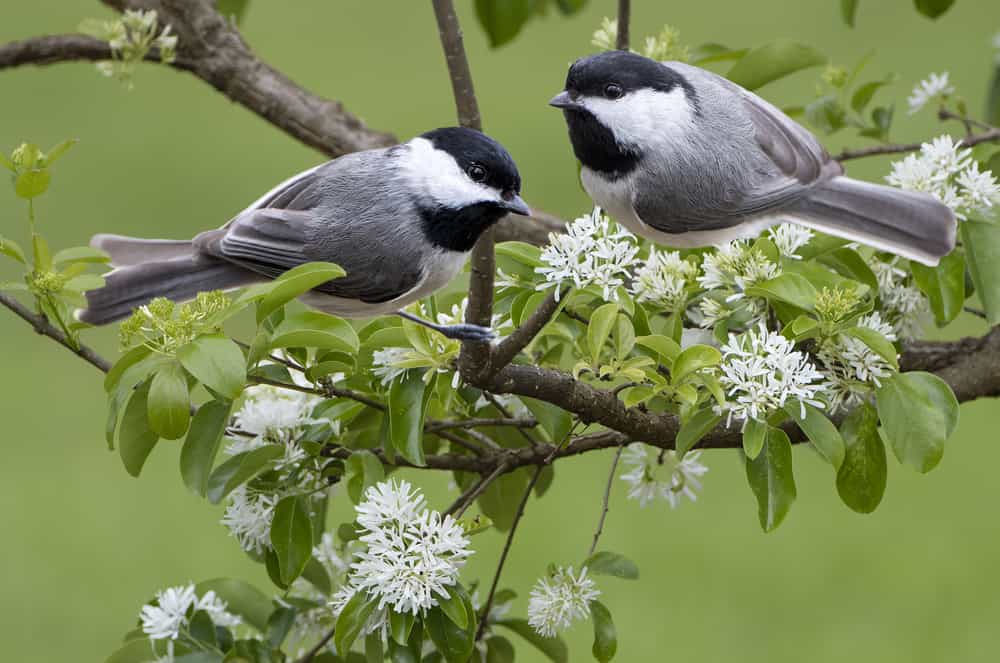One of North America’s family-favorite birds (and the state birds of Maine and Massachusetts!). They can be found hopping and zipping to and fro in backyards from Maine to Montana, New York to New Orleans, and Calgary to California, the chickadee is a delightful animal.
There are quite a few different species of chickadee found in the USA, Canada, and parts of Mexico, as well as elsewhere in the world. But the name ‘chickadee’ is particular to the United States of America. In other countries, they would instead be known by their genus name ‘tit’.
Thankfully, chickadees are super active and numerous birds, which will most definitely be happy feeding from bird feeders and bathing in bird baths placed in the front and backyards of American homes.
In this article, its our goal to provide as much useful information about these curious, spritely little creatures as we possibly can.
We’ll walk you through what chickadees are (including information about their young, their habitats, their migratory patterns and more), before focusing more specifically on chickadees’ diets. Finally, we’ll examine the predators of chickadees, before giving you our 3 top tips on how to attract chickadees to your garden.
Let’s get started!
What Are Chickadees?
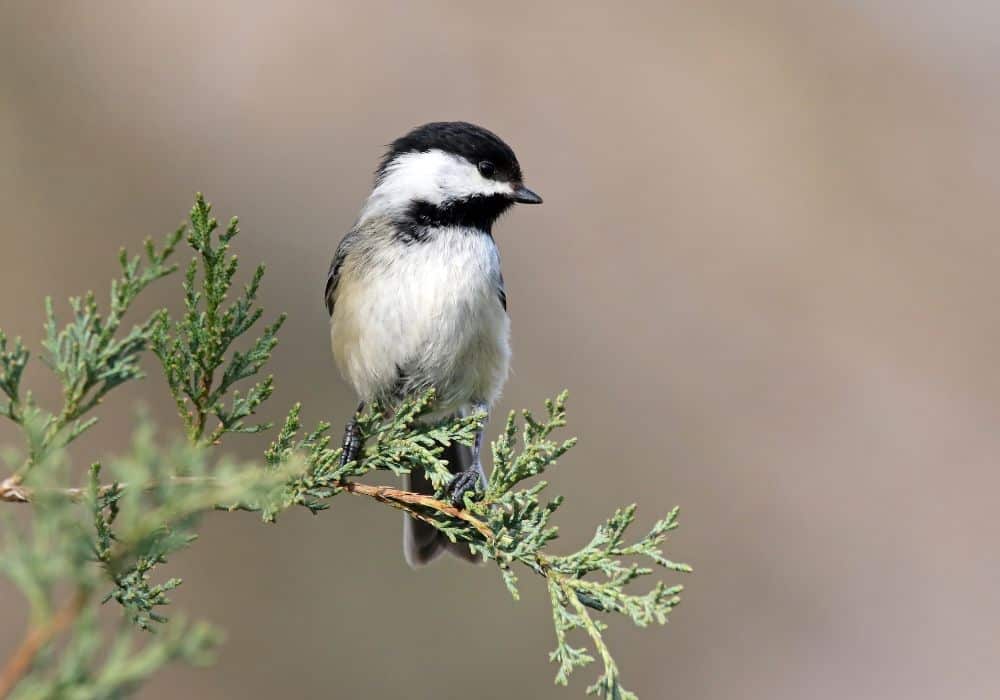
‘Chickadee’ is the North American name for several species of small, passerine omnivorous birds in the ‘tit’ family. As such, they are counted by some as a bird type native to North America, though truly they have relatives throughout much of the world.
Physical Appearance of Chickadees
Chickadees are… well, how to put it? Chickadees are small, undeniably adorable balls of fluff and feather! They are are small in size, ranging from just 6-14cms (2.4″-5.5″) and weighing in at a heart-melting average of 9–14g (0.32–0.49oz).
As passerines, they have hyper-tensile claws able to cling to even the smallest twigs and branches. Their bodies are fairly spherical and soft, their tails ranging in size, shape and length depending on the species.
Most notably, chickadee heads are disproportionately large compared to their bodies, appearing almost bigger than their bodies from many angles. They have distinctive markings which helps to differentiate between the different species, and these markings often contribute toward their names.
For example, the black-capped chickadee has a very obvious black ‘cap’ and bib, with white cheeks; whereas, the color of the chestnut-backed chickadee’s back is chestnut brown.
Generally speaking, chickadees are not sexually-dimorphic, meaning that the male and female chickadee looks alike.
Chickadee Species and How to Identify Them
In the United States, and other parts of the North American continent, you’ll find seven different species of chickadee. They are:
- Black-Capped Chickadee
- Boreal Chickadee
- Carolina Chickadee
- Chestnut-backed Chickadee
- Gray-Headed Chickadee
- Mexican Chickadee
- Mountain Chickadee
The Black-Capped Chickadee has a distinctive black cap on his head, with a black bib below the beak and white streaks for cheeks. Their bill is short and squat, whilst their tail is long and thin. These particular chickadees are native to all but the most southern states of the USA.
Boreal chickadees have a cap, too, but theirs is brown with a little pink in it; their chests being reddish-brown with a flash of olive gray. Like black-caps, their cheeks are also white, whilst their tails are gray fringed with white. You’ll find boreal chickadees in the boreal forests of Canada and Alaska.
Confusingly, the Carolina chickadee looks almost identical to the black-capped chickadee, and is most distinguishable not by sight, but by geography. They are native to the south-eastern United States, particularly in Carolina.
Chestnut-backed chickadees are gorgeous creatures, and perhaps my favorite in appearance. They have a dark brown, chestnut cap and black bib, with white cheeks, a strikingly reddish-brown body, and blue-gray tail and wing feathers. They are one of the rarer chickadees, found only in the Pacific Northwest and along the West Coast of upper-California.
The gray-headed chickadee is named for her exquisitely mute color palette. She is gray and white all over, though the gray retains a clear splash of very light brown. She has white cheeks and a dark gray bib, and can be found only in parts of Alaska. It is the rarest of the genus.
Mexico’s Mexican chickadee can be found mostly in western and central Mexico, and resembles, once more, the black-capped and Carolina chickadee, perhaps with the added identifier of a more-obviously ruffled cap.
And finally, the glorious and hardy mountain chickadee! This tiny creature is a real stunner: the only chickadee not to wear a complete cap, but instead have a head striped bill-to-spine in black and white; one black streak in particular resembling some haute couture eyeliner. The mountain chickadee can be found only at elevations above 3,000ft, and only in the western half of the United States and Canada.
What becomes clear when you study the black-capped, Carolina, and Mexican chickadees (which are, not coincidentally, the most common species of chickadee), is that they are perhaps one and the same bird, different only in minute evolutionary and behavioral ways due to the dispersion of their numbers. It seems the greatest difference is simply in the people living in the areas who named them.
Chickadee Habitat
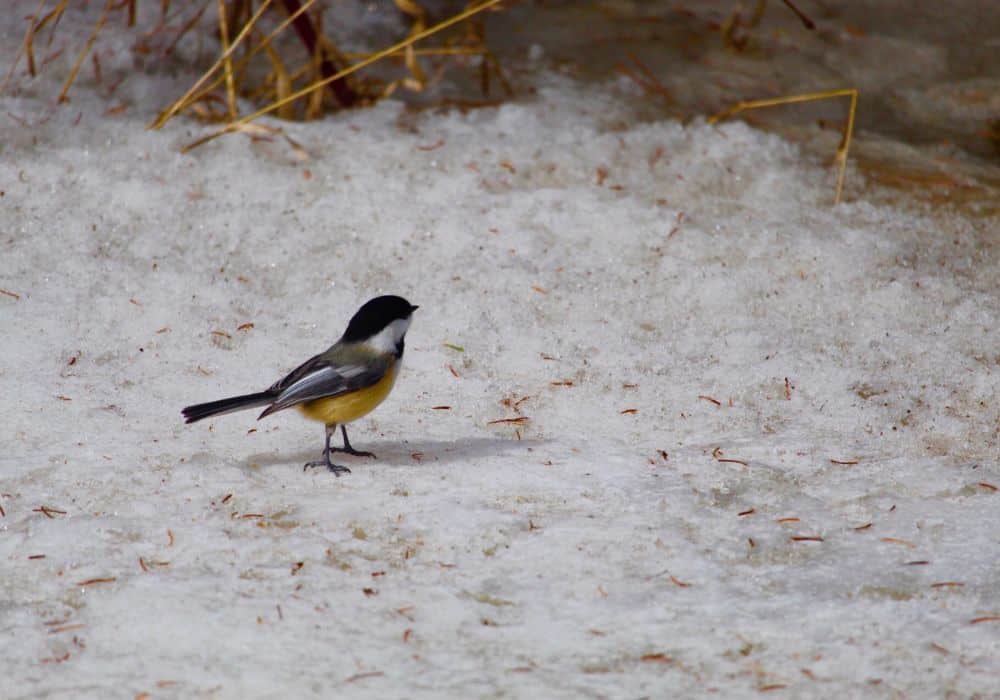
Natively, chickadees existed in the deciduous, arboreal, and mixed deciduous-evergreen forests of North America. They also, however, enjoy forest edges, where hunting for berries and insects is often most fruitful. Chickadees are attracted to any good brush and hedge cover, as well. You can often find them at shelter inn willows, shrubs, birches and alder.
Generally speaking, chickadees are permanent residents of the habitat they inhabit, though it’s not unheard of them to move further south in the winter toward warmer climes, especially during especially cold spells. They can even lower their body temperature (to conserve energy) by up to 12°C. In this, we find the first clear evidence of the chickadee species’ adaptability and keen survival skills.
Chickadees like to sleep in thick vegetation, in cavities and holes in rock, or in holes in tree trunks and so forth. As such, they are particularly fond of nest boxes and birdhouses. Usually, the like to do so on their own, but sometimes will gather in flocks, particularly if there is a perceived heightened risk.
Chickadee Calls
Chickadees were named for their distinctive calls: a very clear “chick-a-dee-dee-dee”. This is, in fact, their alarm call, and their usual call is closer to “fee-bee fee-bee”. When alerting the rest of their flocks to approaching danger, chickadees very cleverly change the number of “dees” at the end of their call! A certain number may mean danger from the sky, by a bird of prey, whilst another number of “dees” may signal danger to the nest, or danger from the ground.
What Do Chickadees Eat?
Chickadees are omnivores, and extremely resourceful birds, tending to eat just about anything they can get their beaks too, especially when food is scarce or the climate is harsh.
However, like all animals, they naturally have a preferred diet: one which delivers them all of the nutrients they need to stay healthy and active.
Here is a comprehensive list of all the things which chickadees commonly eat:
- Birdseed
- Sunflower seeds
- Tree nuts
- Spiders
- Carrion (only occasionally will chickadees eat animal matter, and only when other food is scarce)
- Larvae
- Peanut butter
- Suet
- Invertebrates like bugs and insects
- Berries
- Caterpillars
- Slugs
- Cracked corn
The most interesting part about the chickadee diet is not what it includes, but how they go about interacting with it.
You see, chickadees are what’s called “cachers”. In short, they cache – or store – a truly large percentage of their food. When a chickadee doesn’t have chicks to feed, you’ll often see them grab a seed or two from your garden and then dart away with it.
But that chickadee likely isn’t just a shy eater. Instead, they are probably off hiding the seed somewhere else; storing it for later. They’ll do this by digging holes, or hiding the food under rocks or in crevices in trees.
Some chickadees cache their food throughout all twelve months of the year, but it’s most common for them to concentrate on caching during the Fall, when food is most plentiful, and right before Winter, when it is soon to become scarce.
An individual adult chickadee may have to remember anywhere from a few hundred to many thousands of different spots. To do so, they’ve evolved to have “spatial memory” – this allows them to remember exact cache locations, down to the centimeter, just by using geographical landmarks.
Some species of chickadee, such as the black-capped chickadee, actually produces an abundance of memory cells during the Fall, in fact increasing the size of its hippocampus (the main part of the brain associated with memory), in order to remember all of its cache points.
What Do Baby Chickadees Eat?
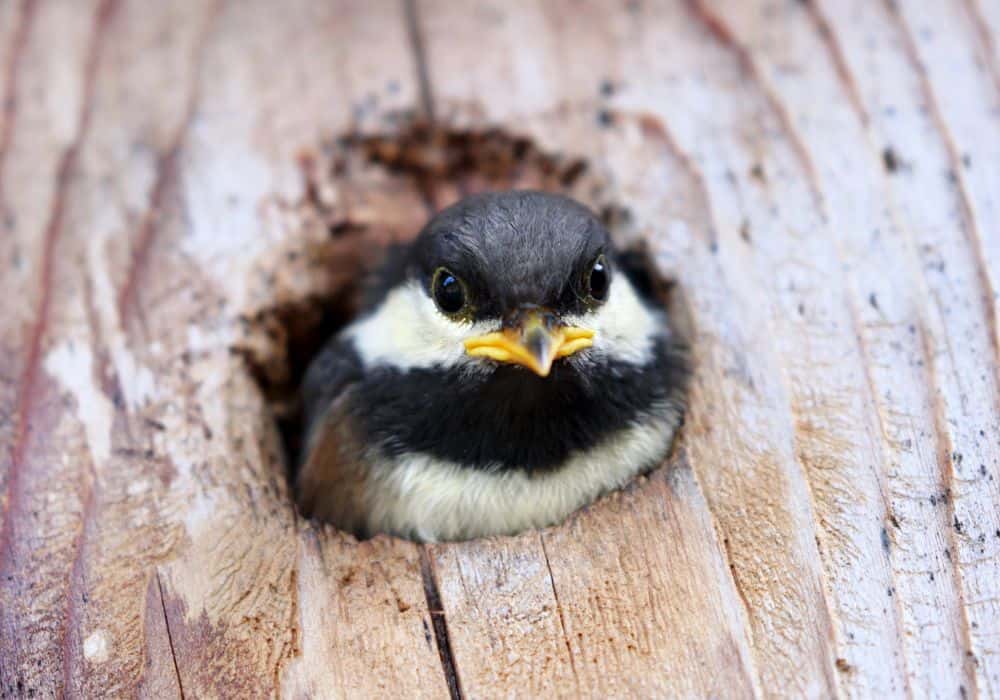
Baby chickadees eat whatever their parents bring them. As falcons do, chickadees do not regurgitate their food into their chicks mouths, but instead bring them food – such as seeds and caterpillars, larvae and slugs – whole.
Both female and male chickadees take part in the feeding of their young.
How Much Do Chickadees Eat?
Chickadees may need to eat up to 1/4 of their body weight every single day because their metabolisms are so fast. This means that a large portion of their day is spent searching for, storing, eating and metabolising their meals.
Chickadee Foraging and Hunting Habits
Chickadees are supremely clever birds, and like to hunt as a flock. Certain species of chickadee, such as the black-capped chickadee, will quickly form a strict social hierarchy when doing so, usually with males taking precedence over females, and old chickadees over younger ones.
They use their distinctive chickadee call to draw the attention of their flock to potential feeding sites. Because of this, other birds like nuthatches, titmice and warblers will sometimes tag along for the ride.
As flock birds, chickadees have evolved to have a particularly unique ability: the ability to replace old neurons with new ones. In essence, this allows them to erase old, no-longer-useful memories, and replace them with new information pertaining to their changing flock and food locations.
What Eats Chickadees?
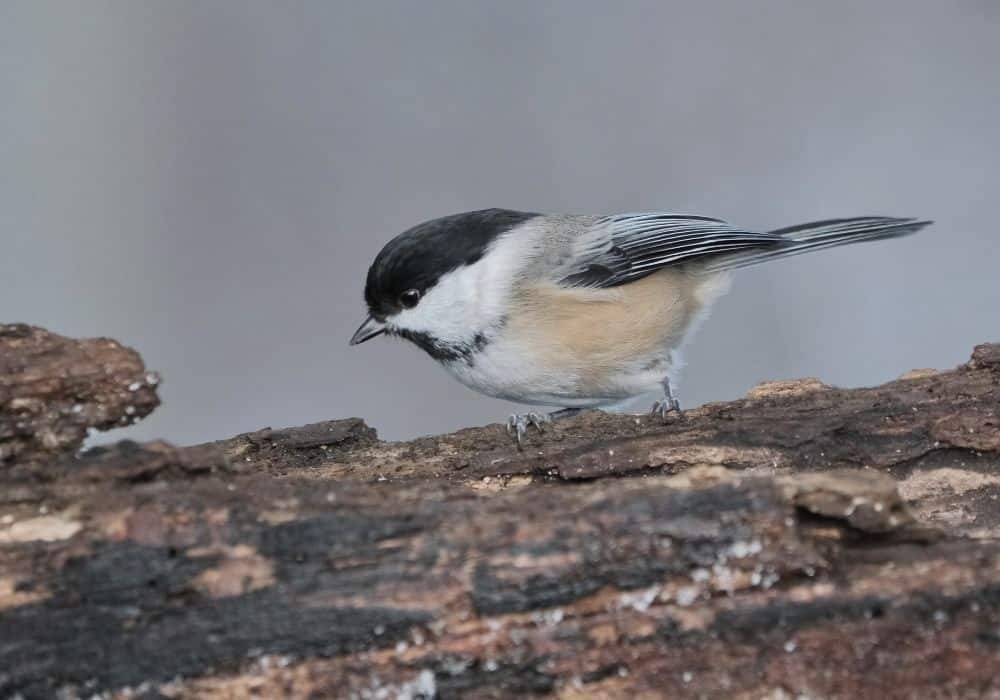
Chickadees are very small birds, and as such are vulnerable to attack and predation by a very many other animals. These animals may attack from the air, like falcons and owls, or from the ground, like foxes. Chickadee chicks are, like most animal young, most vulnerable, and the eggs may even be preyed upon by small, tree-climbing mammals.
Here’s a list of chickadee predators:
- Owls
- Shrikes
- Hawks
- Falcons
- Cats
- Weasels
- Chipmunks
- Snakes (although, sometimes, the chickadee fights back!)
Where Do Chickadees Nest?
Chickadees of all kinds have very particular nesting habits. Most commonly (though this is not true for all chickadee species), they excavate holes in the trunks of snags (dead trees), or occupy holes left by woodpeckers, and there build their nests. They are “cavity nesters”.
Some chickadees, like the mountain chickadee, don’t excavate, but instead will nest under a rock or in a hole in the ground. Many chickadees will take to nest boxes filled with sawdust, or wood shavings.
Both male and female chickadees take part in the nest-building activities, and do so twice a year, each time the female producing up to 13 eggs. Then, the female chickadee will watch over the eggs, sitting on them for incubation, whilst the male hunts for her.
Once the chicks are hatched, both parents help to raise the young to fledgling age.
Top 3 Tips for Attracting Chickadees to Your Garden
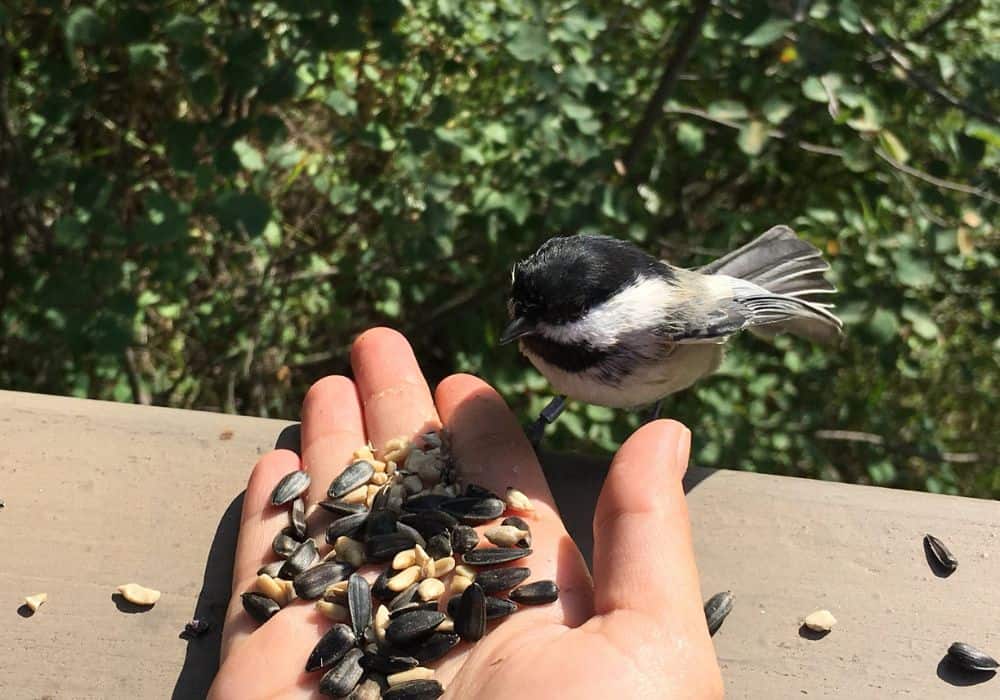
Bird Baths
Chickadees don’t get much water from their diet, and so need to drink in order to stay hydrated throughout their long, and busy days spent foraging for and caching food. Similarly, they absolutely love taking a quick bath in a bird bath.
If putting out a bird bath for chickadees, make sure it’s nice and shallow, rather than deep, as deep bird baths can be dangerous to small birds like these.
Bird Feeders
Of course, the most crucial tip when it comes to attracting chickadees to American backyards is to use the right food. We recommend stocking up your traditional hanging bird feeders with one, or a combination, of the following:
- Safflower seeds
- Nyjer seeds
- Peanuts
- Suet
- Peanut butter
- Black oil sunflower seeds
- Pecans
- Walnuts
- Meal worms
Bird Plants
A lot of the bugs and insects which chickadees like to snack on live in dense shrubbery, bush and hedgerow. Chickadees are also quite skittish, and so like to have a density of vegetation close-by to flit back to at the first sign of danger, hence why they can be most-often found at the forest edge, or on the perimeters of fields.
As such, we recommend planting plenty of vegetation around the borders of your gardens and backyards in order to provide secure shelter from which chickadees can zip back and forth.
Conclusion
Chickadees are a wonderful little species of bird, found right across the North American continent and in a huge range of different climates and habitats. Due to the increasing amount of forest edges and field perimeters (thanks, somewhat ironically, to increased deforestation and agriculture), their numbers are actually increasing in the US! Keep an eye (and an ear) out for chickadees wherever you are.
